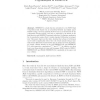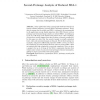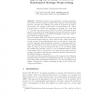51 search results - page 7 / 11 » Using Steganography to Improve Hash Functions' Collision Res... |
FSE
2010
Springer
14 years 1 months ago
2010
Springer
ESSENCE is a hash function submitted to the NIST Hash Competition that stands out as a hardware-friendly and highly parallelizable design. Previous analysis showed some non-randomn...
ACISP
2007
Springer
14 years 2 months ago
2007
Springer
Abstract. Digital signatures are often proven to be secure in the random oracle model while hash functions deviate more and more from this idealization. Liskov proposed to model a ...
FSE
2007
Springer
14 years 2 months ago
2007
Springer
We present a practical attack on the Panama hash function that generates a collision in 26 evaluations of the state updating function. Our attack improves that of Rijmen and cowork...
ACISP
2010
Springer
13 years 6 months ago
2010
Springer
Many applications using cryptographic hash functions do not require collision resistance, but some kind of preimage resistance. That's also the reason why the widely used SHA-...
FSE
2007
Springer
14 years 2 months ago
2007
Springer
Abstract. “Hash then encrypt” is an approach to message authentication, where first the message is hashed down using an ε-universal hash function, and then the resulting k-bi...



